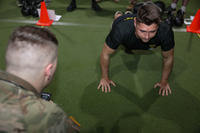When on a Navy war ship (or submarine), you have two issues to deal with: lack of time and lack of space (unless you are on a huge ship, then you will have access to moderately scaled weight rooms -- but you still have the issue of time).
A Navy sailor emailed me and got me thinking back to the underway deployments I was on, and what we did to stay fit -- or at least to maintain an advanced level of fitness. He wrote:
"I'm currently in a deployable billet. I know some people come back a few pounds heavier. I really won't have any control over the food I'm served. I'm going to do pushups and crunches daily, at a minimum. I'm wondering if you have any general suggestions on what I can do to minimize weight gain while I'm on deployment."
Here are some suggestions:
1. Stretch at a minimum
Even when you have just minutes in your day to exercise, you always should do a quick walk around the ship, up a few ladders and then stretch. The "Stretching Plan" article will provide you with a minimum recommended amount of exercise on your busiest days (18-20 hours long).
2. Stay hydrated
Staying hydrated and not getting too dependent on coffee and soda (caffeine) to stay awake will make you feel better, too. Too many sailors drink 8-10 or more cups of coffee a day and drink very little water. This provides a temporary boost in alertness but leaves them very dehydrated. C caffeine is a diuretic and a blood-vessel constrictor.
See the "Want to Lose Weight?" article on the correlation between drinking water and weight loss.
3. Food intake
Calories in = calories out to maintain your weight. The sailor is right about food onboard a ship. You do not have much control over what the ship is dining on, but you can watch your portions and look to eat more fruits, vegetables and lean meats.
These will provide you with the essential nutrients and fiber that will help fill you without adding on the extra calories. Try to avoid fried foods and always have a salad with as many vegetables as you can fit on your plate. This is not easy, but if you do it for 1-2 weeks, you will create the habit of eating light and right. By eating right, you will have the energy to exercise when given the time.
4. Exercise 20-30 minutes a day
Time is usually the issue that keeps many sailors from exercising while underway. But you can get a great workout with little or no equipment. Here are some examples:
The superset is a great way to work out if you have limited time. Each cycle should take you two minutes. If you can do 10 cycles of this, you will total 300 push-ups and 400 crunches. Not bad for 20 minutes.
No resting between sets. You basically rest by doing crunches. The two supersets you see below are great to alternate every other day.
Push-up/crunch superset:
Repeat 5-10 cycles.
-
Regular push-up 10
-
Crunches 10
-
Wide push-up 10
-
Crunches 10
-
Triceps push-up 10
-
Left/right crunches 10/10
-
Pull-ups max
Leg/abs superset:
Repeat five cycles.
-
Squats 20
-
Crunches 20
-
Lunges 10/leg
-
Crunches 20
-
Calf raise 20
-
Crunches 20
We also would bring a metal pole and dumbbells with us on ship to use during the workouts. Place the pole between two upper rafters, and you have a pull-up bar. Another fun workout is the FitDeck made by former Navy SEAL Phil Black. This is a card game that requires you to do a variety of PT exercises every time you flip over a card.
Adding a cardio routine is absolutely necessary for fat burning. Walking, jogging, biking, elliptical gliding and rowing machines sometimes are found onboard ships. If you are so lucky, try the manual mode resistance pyramid on any cardio machine.
Start off at level 1 resistance for one minute. Each minute, increase the resistance by 1-2 levels. Continue up the pyramid until you no longer can pedal, row or run and then repeat in reverse order back to where you started at level 1. This is a great warmup, max-out and cooldown routine, all rolled into one 20- to 30-minute workout.
Swimming alternatives
Many future SEALs, divers and rescue swimmers ask me about trying to keep up swimming muscles while not being able to swim while underway. I recommend focusing on hip flexor, lower back, hamstring and upper-back muscles with a few exercises like:
Hips/abs: Flutter kicks, leg levers and scissors will help you keep the muscles associated with swimming with fins and kicking strong and ready for the beach when you arrive in port.
Lower back/upper back/hamstrings: Swimmers, birds, arm haulers and reverse push-ups will help you with muscles in the upper back, rear shoulders, lower back and back of the legs, with a mix of isometric and non-weight exercises. These exercises also help you balance out the front torso muscles of the chest, abs and shoulders.
See the "New Lower Back Plan" article for more information.
I hope this gives you a few ideas for fitting fitness into your busy day underway. Good luck, and hopefully you will find yourself in a sunny port, so you can hit the beach for a run and a swim. Email me if you have any questions or ideas you do onboard ship.
Stew Smith is a former Navy SEAL and fitness author certified as a Strength and Conditioning Specialist (CSCS) with the National Strength and Conditioning Association. Visit his Fitness eBook store if you're looking to start a workout program to create a healthy lifestyle. Send your fitness questions to stew@stewsmith.com.
Want to Learn More About Military Life?
Whether you're thinking of joining the military, looking for fitness and basic training tips, or keeping up with military life and benefits, Military.com has you covered. Subscribe to Military.com to have military news, updates and resources delivered directly to your inbox.



















